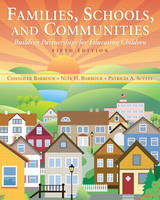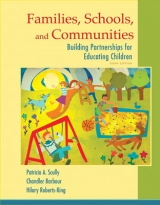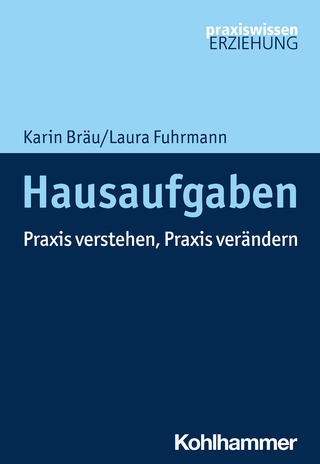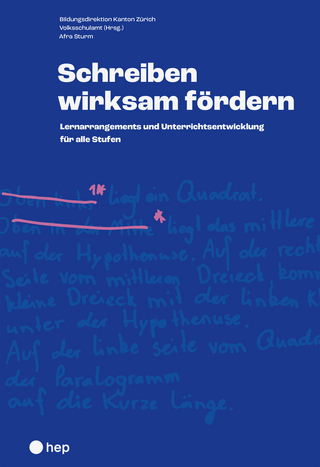
Families, Schools, and Communities
Pearson (Verlag)
978-0-13-703546-5 (ISBN)
- Titel erscheint in neuer Auflage
- Artikel merken
Features include:
Chapter Objectives, Summaries and Questions
Vignettes - real life stories/events that clarify the concepts throughout the chapters.
Reflections - these reflections ask the reader to pause and connect some particular content to their own life experiences.
Implications for Teachers - new feature that provides connections between the ideas in the text and real life application in classrooms and schools.
Bibliography of Children's Literature
New to This Edition:
The authors have added features and rearranged the topics to give this text better coherence and greater usability. Readers will find we have updated references and resources throughout but have streamlined the research citations to provide for smoother reading. We removed the chapter on school curriculum but included suitable parts of that in other chapters. We have renamed some chapters to reflect changes in content, and we have grouped References by each chapter.
New Figures and Tables throughout the chapters update data on demographics of American families and communities.
New vignettes and illustrations to help readers understand the uniqueness of family life and the diversity in our country.
"Implications for Teachers:..." featured in each chapter give readers practical suggestions for trying out the ideas in the real world.
The Special Needs area is addressed more intensely by showing readers how to work with families of children with disabilities.
Family Systems Theory is highlighted to show the importance of understanding total family functioning in addition to the differences of individuals.
Protecting children has a higher profile. Authors include more information on the growing problems and concerns about obesity, bullying, substance and sexual abuse and help readers fit these concerns into the role of education.
Media pluses and minuses are highlighted in our chapters so readers understand when the benefits of expanded media opportunities can shift to exploitation and abuse.
Chandler Barbour, a retired professor of education, has spent over 40 years in elementary school teaching, school administration, and university teaching. His strong interests in educational partnerships for teachers in training and appropriate curriculum for children have led to research and writing on school collaborations and networks. He is a co-author of two earlier publications:Partnerships in Education (1970), AACTE and The Teaching Clinic (1974), Ass'n of Teacher Educators, plus articles and reports for professional journals in Education. In retirement, Mr. Barbour lives in coastal Maine and devotes volunteer time to public school projects, church programs, and prison inmate counseling. He also serves as a board director for a fishing advocacy group, a church facilities board, and one regional hospital board. Nita H. Barbour is a retired University of Maryland professor with over 30 years in teaching, researching and curriculum program development for educational facilities in three states. Her professional work covers involvement with programs for populations ranging from preschool to university graduate courses. Nita's Fulbright Scholarship in language study in the 1950s led to a career long interest in the uses of language and the impact of language and culture on education. This interest has followed her into retirement as a feature of the language literacy programs she has established for preschoolers in her Maine community. Professor Barbour is a co-author of two earlier textbooks in the early childhood field: Early Childhood Education: An Introduction, 4e, 1998, Merrill/Prentice Hall and Developmental Continuity Across Preschool & Primary Grades, 2e, 2004, Ass'n of Childhood Education International. Dr. Patricia Scully is an Associate Professor at the University of Maryland Baltimore County (UMBC) where she directs the early childhood teacher education program and teaches courses in early literacy, children’s literature, and curriculum. Earlier in her career, Dr. Scully taught in child care centers and public school classrooms working with children from two to 12 years of age in New Jersey, New York City, and Maryland. She has been a child care center director and has worked extensively in professional development for child care professionals. She is a graduate of The College of New Jersey, Teachers College, Columbia University and the University of Maryland College Park. Her publications include articles in the Early Childhood Journal and Young Children as well as the book, Developmental Continuity across Preschool and Primary Grades, 2nd Ed. published by the Association for Childhood Education International.
Chapter 1 Home, School, and Community Influences on Children’s Lives
Children’s Perceptions and Attitudes
Age Levels and Influence Influence of Special-Interest Groups
Understanding and Collaboration Summary and Review
Suggested Activities and Questions
Resources
Chapter 2 Historical and Philosophical Perspectives
Overview of Philosophical Viewpoints
Historical Patterns Family as a Significant Educational Force
Community as a Significant Educational Force
Schools as a Significant Educational Force Forces Affecting Education in the Twenty-First Century
Partnerships and Collaborations
Children with Specific Needs
Curriculum Emphasis on Diversity Summary and Review
Suggested Activities and Questions
Resources
Chapter 3 Viewing Family Diversity
Diverse Households are Commonplace in America
Different Types of Family Groupings
Social Factors Relating to Families
Socioeconomic Status of Families
Families with Children with Disabilities
Religious Orientation
Changes in Contemporary Families
Summary and Review
Suggested Activities and Questions
Resources
Chapter 4 Understanding Roles and Experiences of Parents
Nurturance in Families
Family Responsibilities
Cultural Patterns and Family Functions
Interaction Styles Within Families
Experiences of Families
Other Influences on Parenting
Meeting the Challenges of Parenting
Summary and Review
Suggested Activities and Questions
Resources
Chapter 5 Meeting Child-Care Needs from Infancy Through School Age <
History of Child Care
Child-Care Issues in the United States Today
Child-Care Arrangements
Features of Quality Child Care
Licensing Requirements and Voluntary Accreditation
Meeting the Challenges Through Collaboration
Summary and Review
Suggested Activities and Questions
Resources
Chapter 6 Working With Families of Children with Disabilities
Overview of Federal Special Education Laws
Families Raising Children with Disabilities
Children with Disabilities in School
Community Support for Children with Disabilities
Summary and Review
Suggested Activities and Questions
Resources
Chapter 7 Protecting Children While Fostering Learning
Learning Requires Safeguards
Partnering with Parents to Nurture Children at Home
Schools Nurture and Protect Children
Community Responsibility
Linking Responsibilities
Summary and Review
Suggested Activities and Questions
Resources
Chapter 8 Curriculum of the Home
Homes Nurture Communication and Cognitive Skills
Learning Values, Roles, and Responsibilities
Learning from Physical Environments of the Home
Family Practices and Home Learning
Other Family Activities that Educate
Grandparents Provide a Curriculum
Home Schooling
Summary and Review
Suggested Activities and Questions
Resources
Chapter 9 Curriculum of the Community
Community Configuration Affects Curriculum
Social and Emotional Environments in a Community
Physical Environments in a Community
Interactions Among Community Agencies, Families and Schools
Summary and Review
Suggested Activities
Resources
Chapter 10 Establishing and Maintaining Collaborative Relationships
Developing Welcoming Schools and Classrooms
Establishing Ongoing Communication with Parents Parents in the Schools
Working with Selected Families
Handling Collaborative Relationships
Community Involvement
Summary and Review
Suggested Activities and Questions
Resources
Chapter 11 BuildingSchoolPartnerships with Families and Community Groups
Levels of Involvement in Collaborations
Components of Successful Change
Program Models
Features of Successful Collaborations
Achieving Partnerships
Summary and Review
Suggested Activities and Questions
Resources
Appendix I Bibliography of Children’s Books
Different Cultures
Divorced Families
Blended Families
Single-Parent Household and Relationship with One Parent or Grandparents
Adoptive Families
Foster Care, Orphanages, and Shelters
Multigenerational Households and Extended Families
Gay and Lesbian Families
Children, Family Members, and Friends with Special Needs
Homeless Families
Migrant Workers and Immigrants
Religious Traditions
Child Care
Bullying and Intolerance
Sexuality and Child Health
Defining Families
Appendix II NAEYC Code of Ethical Conduct and Statement of Commitment
| Erscheint lt. Verlag | 19.5.2010 |
|---|---|
| Sprache | englisch |
| Maße | 253 x 203 mm |
| Gewicht | 776 g |
| Themenwelt | Sozialwissenschaften ► Pädagogik |
| ISBN-10 | 0-13-703546-2 / 0137035462 |
| ISBN-13 | 978-0-13-703546-5 / 9780137035465 |
| Zustand | Neuware |
| Haben Sie eine Frage zum Produkt? |
aus dem Bereich



